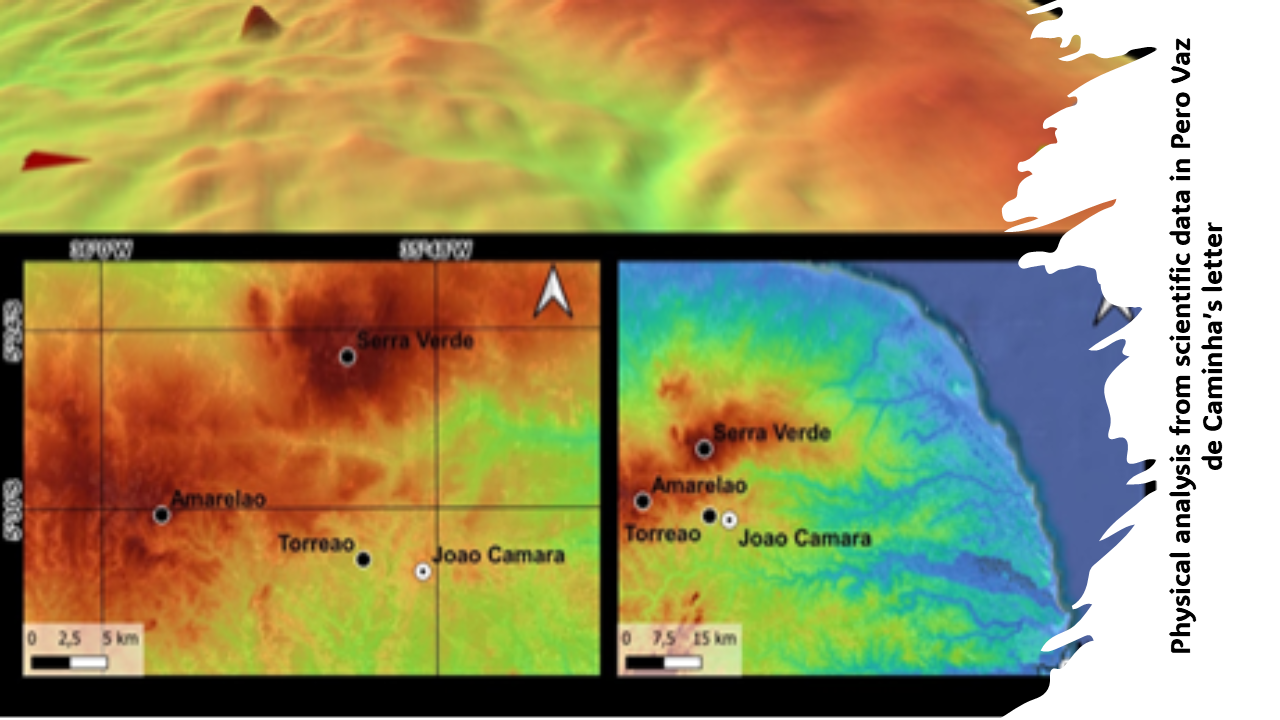Physical analysis from scientific data in Pero Vaz de Caminha’s letter
DOI:
https://doi.org/10.14295/bjs.v4i1.685Keywords:
portuguese navigations, finding Brazil, bathymetryAbstract
The scientific data presented in the letter by Pero Vaz de Caminha, the scribe of Pedro Álvares Cabral's fleet, were physically analyzed when they landed in Brazil in 1500. Initially, it was clarified that the temperature difference between the Equator and the poles, along with the Coriolis force, determined the maritime routes at the beginning of the Age of Discovery, between the 14th and 17th centuries. Our data analysis used modern technological tools such as dynamic internet maps, GPS, and satellite bathymetry data. From this scientific analysis, several conclusions contradict current historical truths. The main conclusions are that the true Mount Pascoal is today known as Mount Serra Verde, located near the city of João Câmara, that the landing site was at the mouth of the Punaú River, at Zumbir Beach, and that the fleet landed at Marco beach and not Porto Seguro, Bahia state. All of these locations are on the northern coast of Rio Grande do Norte state.
References
Brasilescola. (2024). https://brasilescola.uol.com.br/geografia/correntes-maritimas.htm. Acsessed in May 2024.
Britannica, Encyclopedia Britannica (2023). "Buys Ballot’s law". https://www.britannica.com/science/Buys-Ballots-Law. Accessed in 13 June 2023.
Bueno, E. (2019). Coleção Brasilis, A viagem do descobrimento, vol. 1, Rio de Janeiro, Estação Brasil.
Chesman, C., Cavalvanti-Neto, M., & C. B. S. F. (2023). Força de Coriolis e as grandes navegações do século XV. Revista Brasileira de Ensino de Física, 45, e20220260. DOI: https://doi.org/10.1590/1806-9126-rbef-2022-0260
Coriolis, G-G. (1835). Sur les équations du mouvement relatif des systèmes de corps. (On the equations of relative motion of a system of bodies). Journal de l'École Royale Polytechnique, 15, 144-154.
Diffie, B. W., & Winius, G. D. (1977). Foundations of the Portuguese Empire, 1415-1580, U of Minnesota Press.
Hue, S. (2021). Carta de achamento do Brasil, Ed. Unicamp, Campinas, SP. http://purl.pt/162/1/brasil/obras/carta_pvcaminha/indes.html.
Magalhães, J. R., & Salvado, J. P. (2000). A Carta de Pero Vaz de Caminha, Comissão Nacional para as Comemorações dos Descobrimentos Portugueses, Lisboa. www.fractal.ind.br/acartadecaminha.pdf.
Morrison, S. E. (1993). The european discovery of america, 2. The southern voyages, 1492-1616. Oxford University Press.
Museu de Marinha de Portugal. (2021). Comissão cultural da marinha, descoberta do caminho marítimo para a Índia – A Rota. https://youtu.be/o-Kinc1C6MU. Acessed in November 25/2021.
Silva Santos, D. L. (2010). Métodos e técnicas de pesquisa em história, Unimontes, 11 p. https://cesad.ufs.br/ORBI/public/uploadCatalago/17513616022012
Varnhagen, F. A. (1843). IHGB, tomo V, no. 19.
Velho, A., (1998). O Diário de Álvaro Velho de 1488, O descobrimento das Índias, notas e comentários de Eduardo Bueno, Rio de Janeiro, Objetiva.

Downloads
Published
How to Cite
Issue
Section
License
Copyright (c) 2025 Carlos Chesman de Araújo Feitosa, Cláudio Benedito da Silva Furtado

This work is licensed under a Creative Commons Attribution 4.0 International License.
Authors who publish with this journal agree to the following terms:
1) Authors retain copyright and grant the journal right of first publication with the work simultaneously licensed under a Creative Commons Attribution License that allows others to share the work with an acknowledgement of the work's authorship and initial publication in this journal.
2) Authors are able to enter into separate, additional contractual arrangements for the non-exclusive distribution of the journal's published version of the work (e.g., post it to an institutional repository or publish it in a book), with an acknowledgement of its initial publication in this journal.
3) Authors are permitted and encouraged to post their work online (e.g., in institutional repositories or on their website) prior to and during the submission process, as it can lead to productive exchanges, as well as earlier and greater citation of published work.



